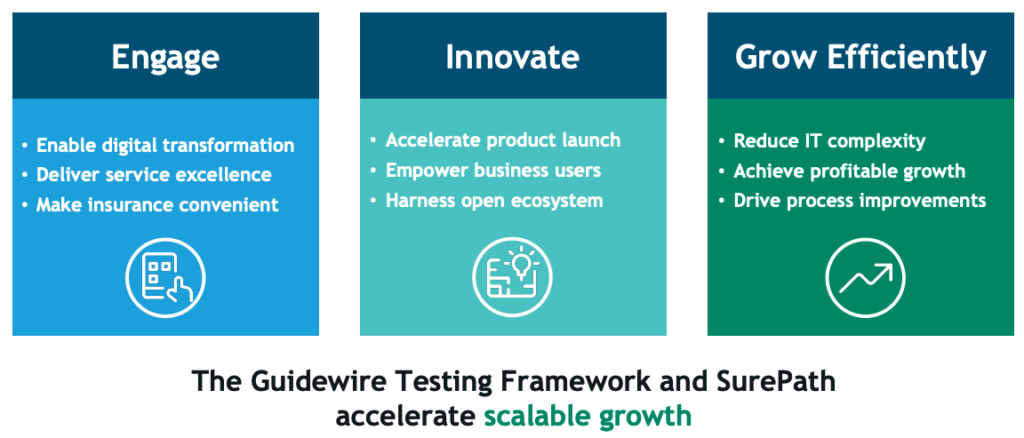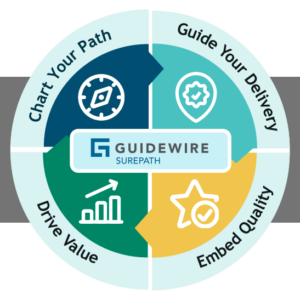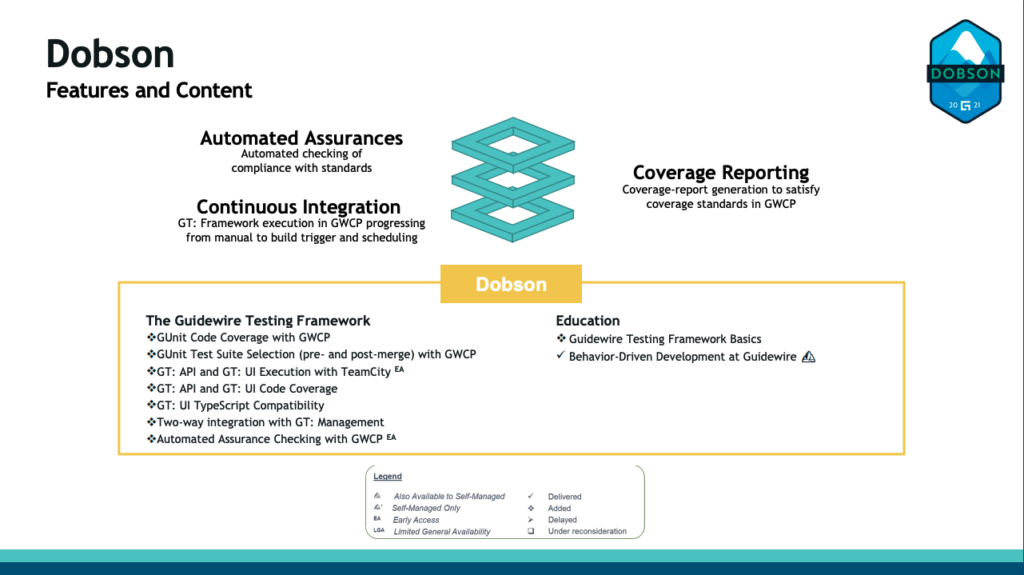The following post is a transcript of content that was presented by Zachary Griesbach at the Connections 2021 session titled “Accelerate Delivery with Guidewire Testing and SurePath.” It has been condensed and edited for easier reading.
I’m Zac Griesbach, the Practice Director of Testing and Performance Frameworks at Guidewire. This session will include the product and delivery. For today’s agenda, we want to talk about Guidewire’s vision and our mission around testing. Then we’d also like to have a conversation about the Testing Framework itself, what’s inside of it, as well as SurePath.
Three Essential Imperatives
Every insurer is essentially driving at these three things: engage, innovate, and grow efficiently.

The Guidewire Testing Framework (GT: Framework) paired with SurePath accelerates efficient and scalable growth, and the GT: Framework reduces the IT complexity required to standardize this non-differentiated heavy lifting. That way, you can free up your business to then innovate and engage.
Guidewire Testing Accelerates Delivery of Value
Our vision is world-class product quality, extended through delivery with every Guidewire Cloud solution. To achieve that vision, we have three primary objectives:
- Early defect detection
- Fast feedback on changes
- Collaborations to enable fast implementations
We also aim to provide common testing infrastructure using modern industry standard test automation tools. And it’s all intended to have well-tested implementations as an input for faster and faster updates.
SurePath Embeds Quality
 Every customer and every partner has an existing quality ecosystem. So, the GT: Framework must ensure key points of interoperability with your quality ecosystem. We enable and embed quality in the Guidewire Testing Framework with SurePath features, such as:
Every customer and every partner has an existing quality ecosystem. So, the GT: Framework must ensure key points of interoperability with your quality ecosystem. We enable and embed quality in the Guidewire Testing Framework with SurePath features, such as:
- Estimation tools to make sure that we’re creating space in your project plan to build out automation with every story
- Automated assurance checking
- Persona-based training and certification
- Enablement collateral to help adapt these testing investments
- Quality processes, strategies, standards, SurePath tests, etc.
Behavior-driven development (BDD) is Guidewire’s selected approach to focus on increased collaboration, a shared understanding, and to make sure that your investment is more easily, and cost effectively maintained as you move on through into your operations with Guidewire.
Guidewire Testing Framework Capabilities
The GT: Framework contains three primary capabilities: GUnit, GT: API, and GT: UI. Adding to these primary capabilities is GT: Data and GT: Management.
GUnit
The GT: Framework contains these three primary capabilities, starting first with GUnit. GUnit is an in-process unit testing framework built for Gosu. It uses a builder-based test data approach, and we do not provide reference tests on the base product with GUnit, though most of the Marketplace content that you download will come with GUnit tests.
GT:API
GT: API is an out of process API testing framework built on Karate. You can author API unit tests using Karate scenarios and end-to-end behavior tests leveraging Cucumber. It uses an API approach for its test data, and we have the additional test content in the Guidewire Marketplace to help accelerate the adoption.
GT:UI
GT: UI is also an out of process testing framework, this time built on TestCafe. It also leverages Cucumber to support behavior testing. It contains an awesome feature called GT: Ignite. This supports page object generation for the InsuranceSuite applications, as well as Jutro-based applications. It also has API-based test data, and we have available content in the Marketplace to help support the adoption.
GT: Data
This is our approach and our tooling for test data management. The test data strategy provides our guidance in our approach, and the test API provides the data for GT: API and GT: UI.
GT:Management
GT: Management is test case management with Jira Cloud Software and Xray. It syncs GT: API test cases with Xray, and it enables recording the execution results back into Jira Cloud.
What’s Next for the Guidewire Testing Framework?
Looking at Guidewire’s testing milestones, we’ve delivered a foundational set of capabilities in our framework. Accelerating upward, we’ve launched off that foundation to provide what you’ve immediately requested for scalable and supportable adoption. And we’ve prioritized the features in our backlog that you have told us that are important, such as standardized quality gates, adding your own testing, adding your own inspections, standardizing test data sets, combinatorial testing, performance testing, and a lot more.
With Cortina, we released the foundational set of capabilities with the GT: Framework, and that included GT: API, GT: UI, and GT: Management. And with this foundation on every single release, we will continue to grow. There are reference tests that have been released to the Marketplace for the designated functions on policy, billing, and claims on GT: API and GT: UI. And we’ve updated the GUnit education to help offer more fluent and maintainable cloud-compliant unit tests.
What’s Available with Dobson?
The GT: Framework will be enhanced with self-service GUnit code coverage through the Guidewire Cloud Console, adding the ability with test suite selection for pre- and post-merge.

Next, GT: API and GT: UI will have the ability to contribute to code coverage, and that will happen through local execution, yet there will be an Early Access (EA) feature for select customers to hook this up through TeamCity. And building on that foundation that I mentioned in Cortina, we’re focused on enhancing the developer experience. GT: UI will be gaining TypeScript compatibility, and GT: Management will now have a 2-way integration. Simply put what this means is that we can author tests scenarios in Jira and push them to GT for automation.
New and Updated Training Courses
Finally, to support scalable adoption for our customers and partners, we’ve updated and created new training courses around SurePath, the GT: Framework, as well as BDD:
- SurePath Overview
- Guidewire Testing Framework Overview
- Guidewire Testing Framework Basics
- Behavioral-driven Development at Guidewire
These courses are meaningful to both Cloud customers and customers who are Self-Managed and looking to learn behavior-driven development prior to moving to the Cloud.
Guidewire recognizes that there’s a worldwide imperative with project teams to move fast, and that’s why we need quality at speed. With each release we’re investing more, because Guidewire delivers quality by delivering value.
Audience Q&A
Question 1:
We have the core InsuranceSuite and CustomerEngage. Can you talk a little bit about the integration testing that Guidewire testing supports? More of what the tools will do? You mentioned unit testing and so forth. Just how do the test cases, how does the actual testing support different integrations that might come into play?
Answer (Zac Griesbach):
Yeah, that’s a really good question. As you know at Guidewire, we have multiple integration frameworks and things that we build as well. And what are we using? GT: API is what we are leveraging for quite a bit of the integration testing ourselves. GT: API and GT: UI are end-to-end testing tools that are not limited to the Guidewire ecosystem. They’re open-source technologies. Guidewire provided a thin layer of proprietary technology on top of them to help make it easier to author tests on our own core products. However, for the most part, a customer can take these tools and they can write tests going across any of their own applications as well.
From a support side, that answer would vary. As an example, Guidewire will only be interested in and execute tests for testing our applications. If a test went from a third-party application into our application, and then the test broke, we can really only look at how it broke within our application.
Question 2:
Do you have any examples with document testing, whether it’s testing of email generation and other elements of communications that come out through Guidewire?
Answer (Zac Griesbach):
That is a good question, and that has come up with several customers recently. Our partners do a fantastic job at document testing. One of the capabilities we’re looking at doing a little bit more on is some aspects of visual testing, which could help with this. We can test the payload being delivered to the document. However, document testing is a bit trickier and focusing on the payload can be error prone. Customers have put a lot of logic into the document generation systems and forms generation. They want to do some type of visual testing on the end. When we look to solve that problem, we’re reviewing this experience and the options. We haven’t produced a solution on that side, yet, but we do have some options that tack on to TestCafe, that we can share.
Question 3:
Hi, we have on-prem right now, we have a lot of automation scenarios by using our own Selenium and all. So, moving from on-prem to Cloud, do we need to rewire them, like finding that each element detecting that? Do you see anything changes in there from on-prem to Cloud?
Answer (Zac Griesbach):
I’m going to repeat it and let me know if I lose the value of your question. “If I have an existing testing investment, such as in Selenium, when I join your cloud, what happens? It sounds like I have to adopt your tools.” The answer is that your existing testing investments are safe. You can keep them, and in fact, we encourage you to keep them to the extent that you see value in it, because look at my t-shirt, right? The more quality, the better, right? That’s a win-win solution for Guidewire. It’s a win-win solution for our partners.
So, what happens is Guidewire can only operate the Guidewire Cloud Platform and continuous integration with so many of those testing frameworks. We have to have a standard set of frameworks that we will plug into our CI/CD, or our operational teams will be overwhelmed on how many things that they would need to support. What we do is we say, “These are the frameworks that we will enable, and we will operate [the GT: Framework]. Whereas everything that you have, you can continue to operate, against all of our test environments in the cloud. And we absolutely encourage it, but there has to be minimal investment into the Guidewire Testing Framework with transition to the cloud to support alignment with our product strategy for updates.”
Question 4:
Could you elaborate a little bit on GUnit pre and post merge please?
Answer (Zac Griesbach):
Thanks for the question. Customers have been asking us a lot more about quality gates, when can we get more functionality from Guidewire around quality gates, etc. The framework itself is a testing framework. Building it into CI/CD is Guidewire Cloud Platform (GWCP) capability. As a developer, you check in code and if the pre and post merge feature is set up through the Guidewire Cloud Console (GCC), the test suites that you’ve selected, such as a smoke suite or designated functions will run as your pre-merge or your post-merge with the check-ins. This will help you set up the right initial quality gates to merge. And as Guidewire provides more maturity in these areas, we’ll start to define what suites should always run with each gate, to standardize our gates.
Question 5:
I was just wondering, you talked about performance being a priority. Can you talk a little bit more about performance testing, or that framework that you might have available with SurePath?
Answer (Zac Griesbach):
In the Guidewire documentation today, there’s a book for GT: API, and there’s a page in it for performance testing. Search for the term “Gatling.” What that’ll do is it’ll give you a one-pager on how to use Gatling with GT: API, which is just using Gatling with Karate for the most part. This is our intended approach, with more to come in Elysian.
Question 6:
Is the GT: Framework mainly for Self-Managed or Cloud, or what is the direction from your side please?
Answer (Zac Griesbach):
The GT: Framework is Cloud-first, and we try to backport capabilities to Self-Managed where it makes sense.
If I’m a Self-Managed customer, I have GUnit that’s available for both Self-Managed and Cloud. And if I’m a Self-Managed customer, I might have been thinking about ISBTF. We’re asking Self-Managed customers not to grow their investment in ISBTF, as it does not align with the go-forward strategic product direction. Our guidance is to focus on learning behavior-driven development. It sounds like a very simple thing to do, but sometimes the change in organizational processes can be the most difficult thing to figure out. To learn BDD for Self-Managed, customers can pick any framework or tooling. We prefer, and I think it would make sense, that customers would align their tech stack. Guidewire makes available the fact that our tech stack includes Karate, TestCafe, Cucumber, all with the intent to reduce friction with fewer skill sets to try and align later.
If you need assistance, both Self-Managed and Cloud customers should consider working directly with Guidewire Delivery Services, or one of our badged testing standardization partners. These are partners that have specifically aligned with us on the topics presented today, our strategy, tooling, and approach for your projects.
About the Author

Zachary Griesbach
Practice Director, Testing and Performance Frameworks